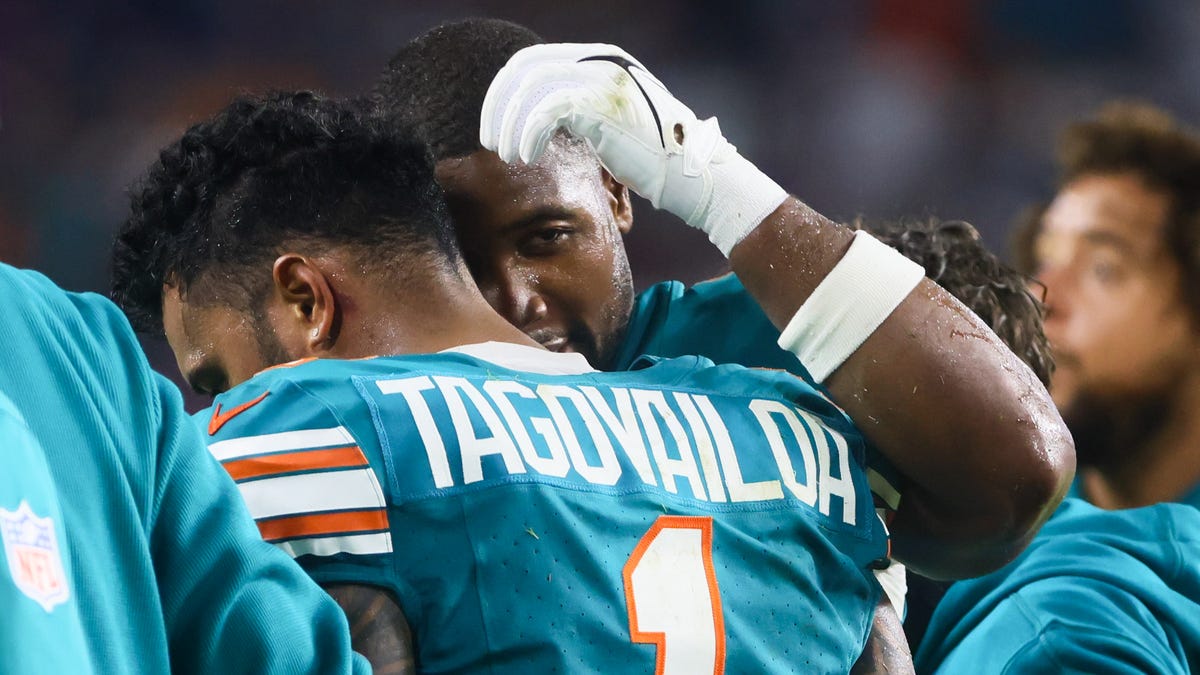We should not be urging Miami quarterback Tua Tagovailoa to retire. Instead, it’s his family’s role.
We have witnessed this alarming scene before with Tua Tagovailoa. It’s terrifying. He lies on the ground, seeming unconscious. Teammates urgently signal for medical assistance. Others kneel around him in concern. The crowd goes silent. People pray. Commentators speak in serious tones. Everyone is asking the same question.
Is he alright? Will he get back up? This happened again? He’s down like that again?
Dolphins offensive lineman Austin Jackson shared with journalists post-game that he was near Tagovailoa and could tell from Tagovailoa’s eyes that he “wasn’t fully present.” Jackson said he immediately knelt down in concern. Skylar Thompson, the Dolphins’ backup quarterback, expressed what many felt upon observing Tagovailoa’s fall: “It makes me sick,” he said. “Everyone in the organization feels the same way. I’m just really praying for Tua, hoping for a positive outcome.”
We all share that hope. However, there’s a much larger conversation to explore here. It’s a complex and uncomfortable topic. It revolves around love, concern, and accountability. The NFL has a responsibility here. So do we. So does his family. It’s important for all of us to take a moment to reflect on this: thoughtfully, with compassion and respect, yet also with a critical perspective.
We must discuss everything involved, including the fencing response, which indicates severe neurological harm. We should not avert our gaze. We should not compartmentalize. We must not trivialize.
Above all, this is essential for Tagovailoa and his family to consider. While I don’t dictate how others should lead their lives, I cannot ignore the reality I observe. It doesn’t take a brain specialist to see that Tagovailoa’s situation is perilous. It’s clear that repeated concussions are detrimental to his long-term wellbeing.
None of us ought to pressure him to retire, but those closest to him should. His family and friends must discuss the risks thoroughly—CTE, Parkinson’s disease, and more.
Have open conversations. Ultimately, Tagovailoa and his family may conclude that the potential risks are acceptable. He might believe that he’s building wealth for future generations, motivating him to stay on the field. Yet, someone close to him could remind him that his previous contract provided nearly $100 million in guaranteed salary at signing.
We all share in the responsibility of engaging with this exhilarating yet violent sport. Football is so harsh that the player Tagovailoa collided with was Damar Hamlin, who had to be resuscitated right on the field.
We immerse ourselves in coverage, participate in fantasy leagues, and lounge on our couches with snacks. While the NFL may overlook the human aspect of the game at times, we don’t have to. We can remain mindful and reflect on the situation facing Tagovailoa, recognizing him as a person.
This incident marks Tagovailoa’s third confirmed concussion in the NFL. The circumstances surrounding his previous concussions were so alarming and poorly managed that the league had to reform its concussion protocols. Coincidentally, no sports league has handled head injury issues as poorly as the NFL over the years, delaying acknowledgment of the long-term repercussions of such trauma, including CTE. The swift changes in policy illustrate just how serious the matter became.
In 2022, during a game against Buffalo, Tagovailoa hit the back of his head on the ground. He struggled to rise but fell back into the huddle. The incident was initially brushed off as a back injury.
The NFL and NFL Players Association initiated a joint inquiry into the occurrence. Following this, the union exercised its right to terminate the unaffiliated neurological consultant who had allowed Tagovailoa to return to the game. The league updated its concussion policy, introducing a spotter with the authority to remove any player showing signs of concussion.
Just four days later, when facing Cincinnati, Tagovailoa again hit the back of his head and fell unconscious. He was hospitalized and diagnosed with a concussion. He endured another concussion later that same season against Green Bay.
Additionally, Tagovailoa experienced a concussion during his college years at Alabama.
This is Tagovailoa’s narrative. It’s his tale, as well as that of his family.
During a discussion on “The Dan Le Batard Show” in August, Tagovailoa revealed that his mother advised him to think twice about continuing to play football.
We can only hope that such discussions are taking place once more.

